Table of Contents
Introduction to Barb Fish
Barb fish are a diverse group of small to medium-sized, freshwater fish belonging to the Cyprinidae family, widely popular among aquarium enthusiasts for their vibrant colors and dynamic behaviors. Known for their distinctive barbels, which resemble whiskers and give them their name, barb fish are found in various habitats ranging from fast-flowing streams to still waters across Asia and Africa. These hardy species vary greatly in size, color, and temperament, making them a fascinating choice for both novice and experienced aquarists. Their adaptability to different environmental conditions, alongside their lively nature, contributes to their popularity in home aquariums.
Characteristics of Barb Fish
Here are some key characteristics of barb fish:
- Barbels: One of the most distinctive features of barb fish is the presence of one or more pairs of barbels around their mouth, which are sensory organs used to detect food in the water.
- Colorful and Varied Appearance: Barb fish come in a variety of colors and patterns, ranging from the striking Tiger Barb with its bold stripes to the Cherry Barb, known for its vibrant red hue. This diversity in appearance makes them highly sought after for decorative purposes in aquariums.
- Size: Most barb fish are relatively small, typically ranging from 2 to 5 inches in length, making them suitable for a variety of tank sizes.
- Schooling Behavior: Barb fish are generally social creatures that prefer to live in groups. Schooling helps reduce stress in these fish, making them more vibrant and active. It’s recommended to keep them in groups of at least five or more to mimic their natural social structure.
- Temperament: While many barb species are peaceful and make great community fish, some can be semi-aggressive, especially if not kept in adequate numbers or if the tank is too crowded. Proper research on specific species is essential before introduction to a community tank.
- Adaptability: Barb fish are adaptable to a range of water conditions, but they thrive in clean, well-oxygenated water with a moderate flow. They can tolerate a wide range of temperatures, making them suitable for various aquarium setups.
- Diet: They are omnivores, feeding on a mix of plant and animal matter. In aquarium settings, they can be fed a variety of foods, including flakes, pellets, live, and frozen foods, ensuring a balanced diet.
- Breeding: Many barb species can be bred in captivity, but they often require specific conditions to do so. They typically scatter their eggs among plants and substrates. Some species may eat their eggs or fry, so it’s sometimes necessary to remove the adults after spawning.
Types of Barb Fish
There are many different types of barb fish. The most common type of barb fish is the tiger barb. Other types of barb fish include the gold barb, the cherry barb, and the glowlight barb. Below is the 10 Popular types of barb fish:
Tiger Barb
Tiger Barbs are lively and colorful fish known for their bold stripes and energetic behavior. They are a popular choice for community aquariums.
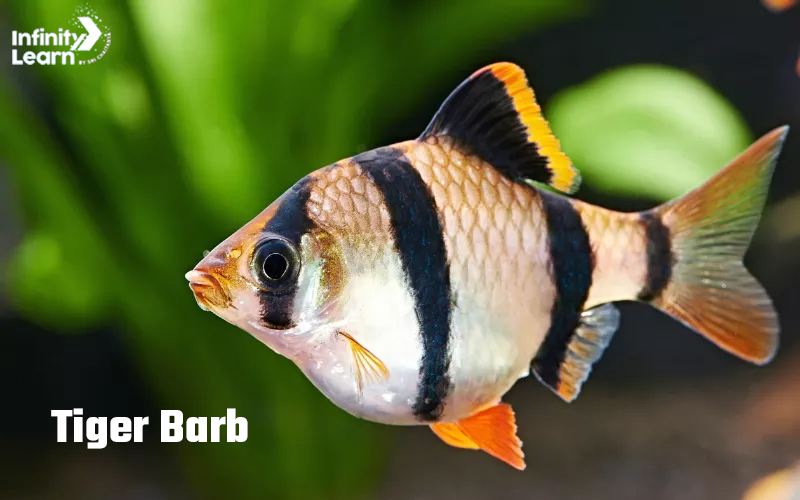
- Scientific Name: Puntigrus tetrazona
- Place of Origin: Southeast Asia
- Size When Fully Grown: Up to 3 inches
- Expected Lifespan: 5 to 7 years
- Smallest Recommended Aquarium Size: 20 gallons
- Water pH Level: 6.0 to 7.0
- Water Hardness Level: 5 to 19 dGH
- Optimal Water Temperature: 72°F to 82°F (22°C to 28°C)
Cherry Barb
Cherry Barbs are peaceful and slender fish, cherished for their striking red color, especially in males during spawning.
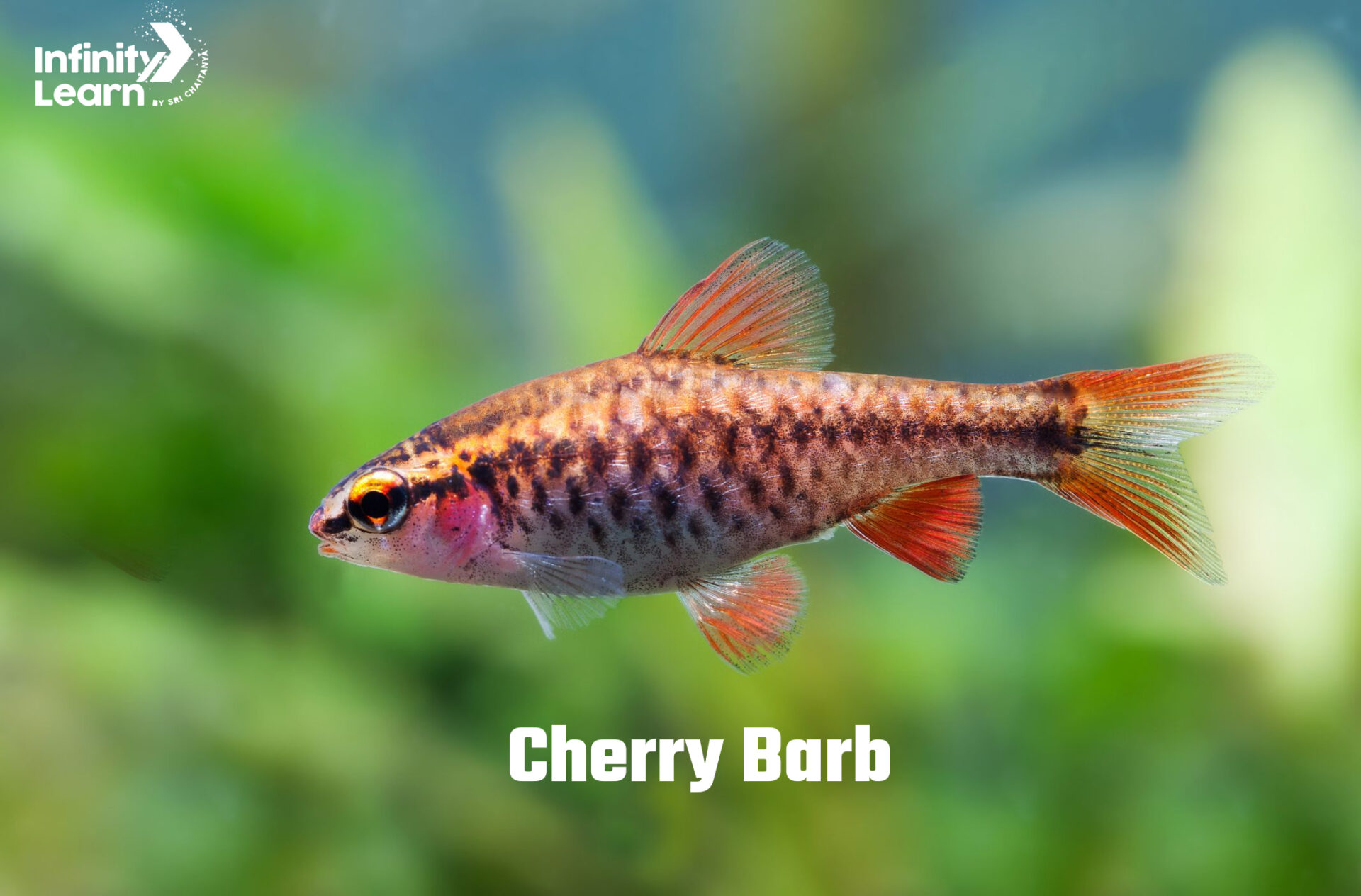
- Scientific Name: Puntius titteya
- Place of Origin: Sri Lanka
- Size When Fully Grown: Up to 2 inches
- Expected Lifespan: 4 to 6 years
- Smallest Recommended Aquarium Size: 20 gallons
- Water pH Level: 6.0 to 8.0
- Water Hardness Level: 5 to 19 dGH
- Optimal Water Temperature: 73°F to 81°F (23°C to 27°C)
Rosy Barb
Rosy Barbs are robust and active fish with a pinkish hue that intensifies during breeding season, making them quite attractive.
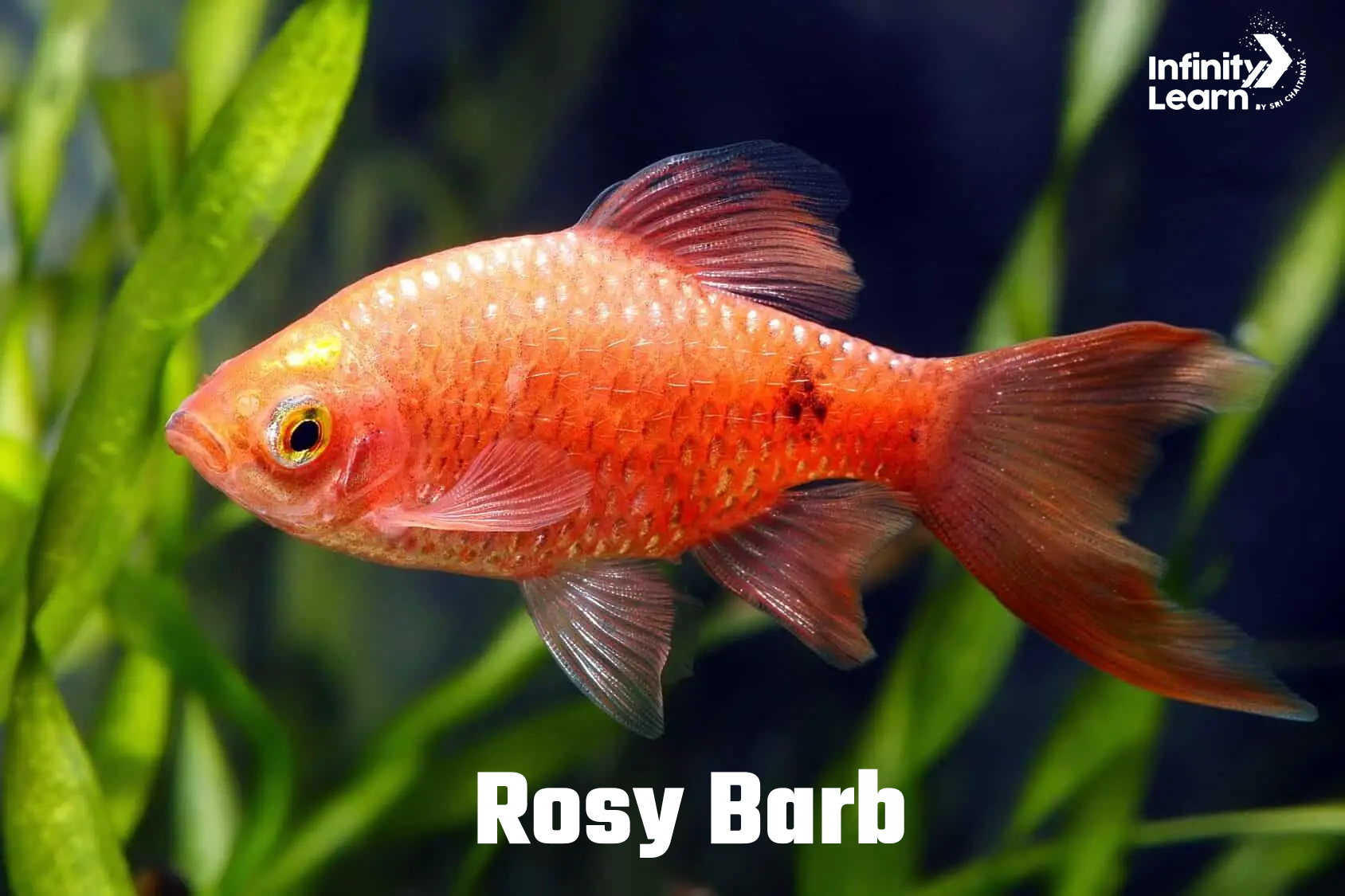
- Scientific Name: Pethia conchonius
- Place of Origin: India, Bangladesh
- Size When Fully Grown: Up to 6 inches
- Expected Lifespan: 5 years
- Smallest Recommended Aquarium Size: 30 gallons
- Water pH Level: 6.0 to 8.0
- Water Hardness Level: 5 to 19 dGH
- Optimal Water Temperature: 64°F to 72°F (18°C to 22°C)
Tinfoil Barb
Tinfoil Barbs are large and active fish with a silver body and reflective scales, requiring spacious tanks to accommodate their size.
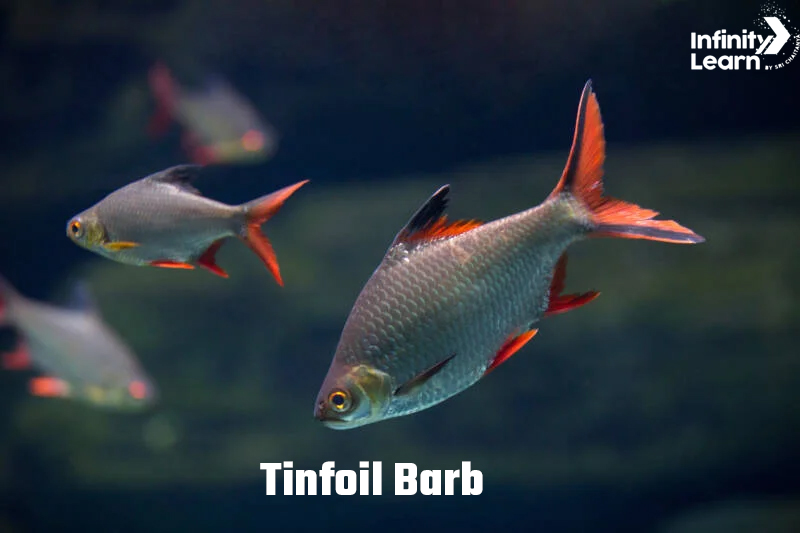
- Scientific Name: Barbonymus schwanenfeldii
- Place of Origin: Southeast Asia
- Size When Fully Grown: Up to 14 inches
- Expected Lifespan: 10 years
- Smallest Recommended Aquarium Size: 75 gallons
- Water pH Level: 6.0 to 7.5
- Water Hardness Level: 5 to 10 dGH
- Optimal Water Temperature: 72°F to 77°F (22°C to 25°C)
Gold Barb
Gold Barbs are peaceful and hardy fish with a golden-yellow body that makes them a favorite among aquarists for their ease of care.
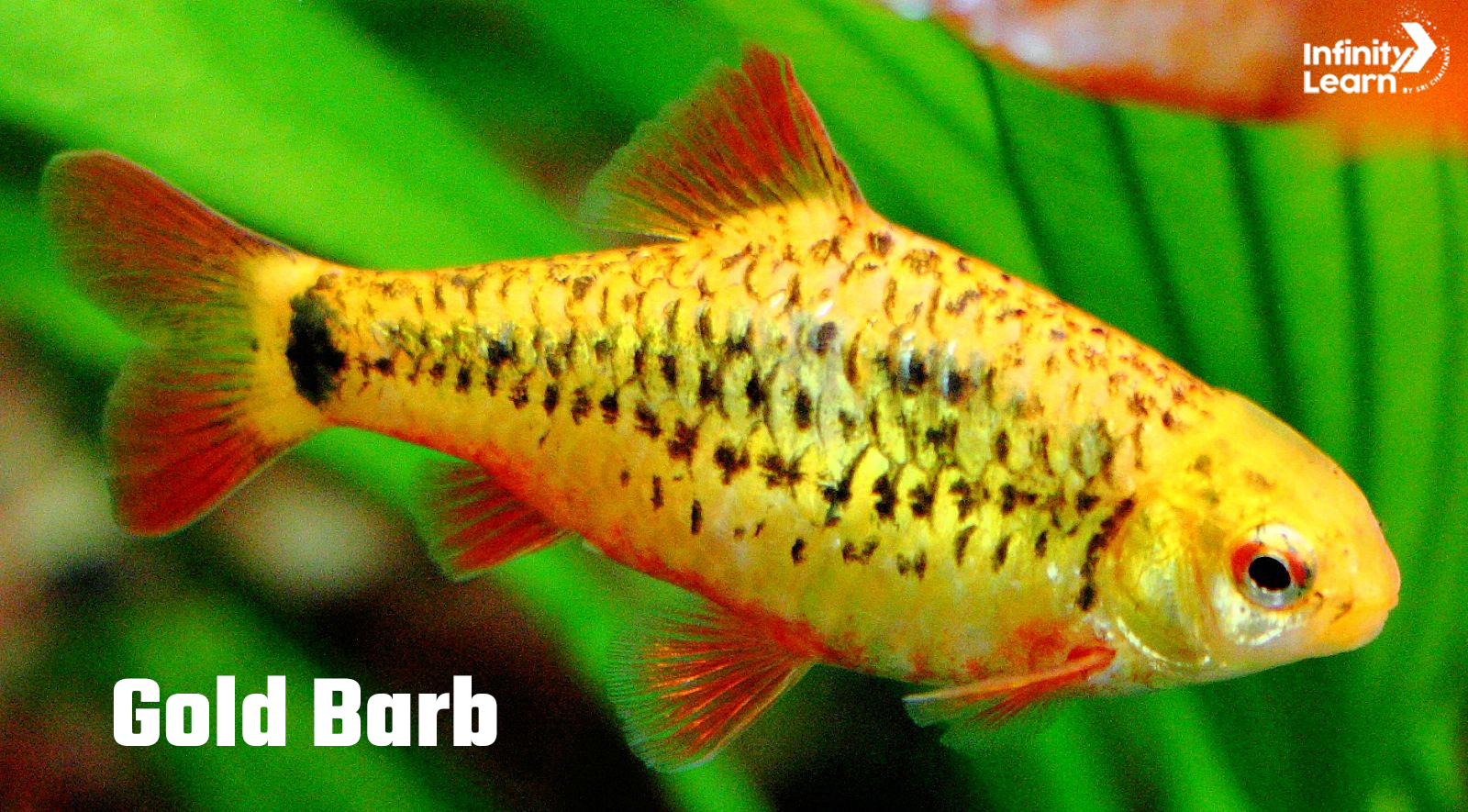
- Scientific Name: Barbodes semifasciolatus
- Place of Origin: China
- Size When Fully Grown: Up to 3 inches
- Expected Lifespan: 5 years
- Smallest Recommended Aquarium Size: 20 gallons
- Water pH Level: 6.0 to 7.0
- Water Hardness Level: 4 to 10 dGH
- Optimal Water Temperature: 64°F to 75°F (18°C to 24°C)
Denison Barb (Red-Line Torpedo Barb)
Denison Barbs are striking fish known for their speed and the distinctive red line running through their body, requiring ample swimming space.
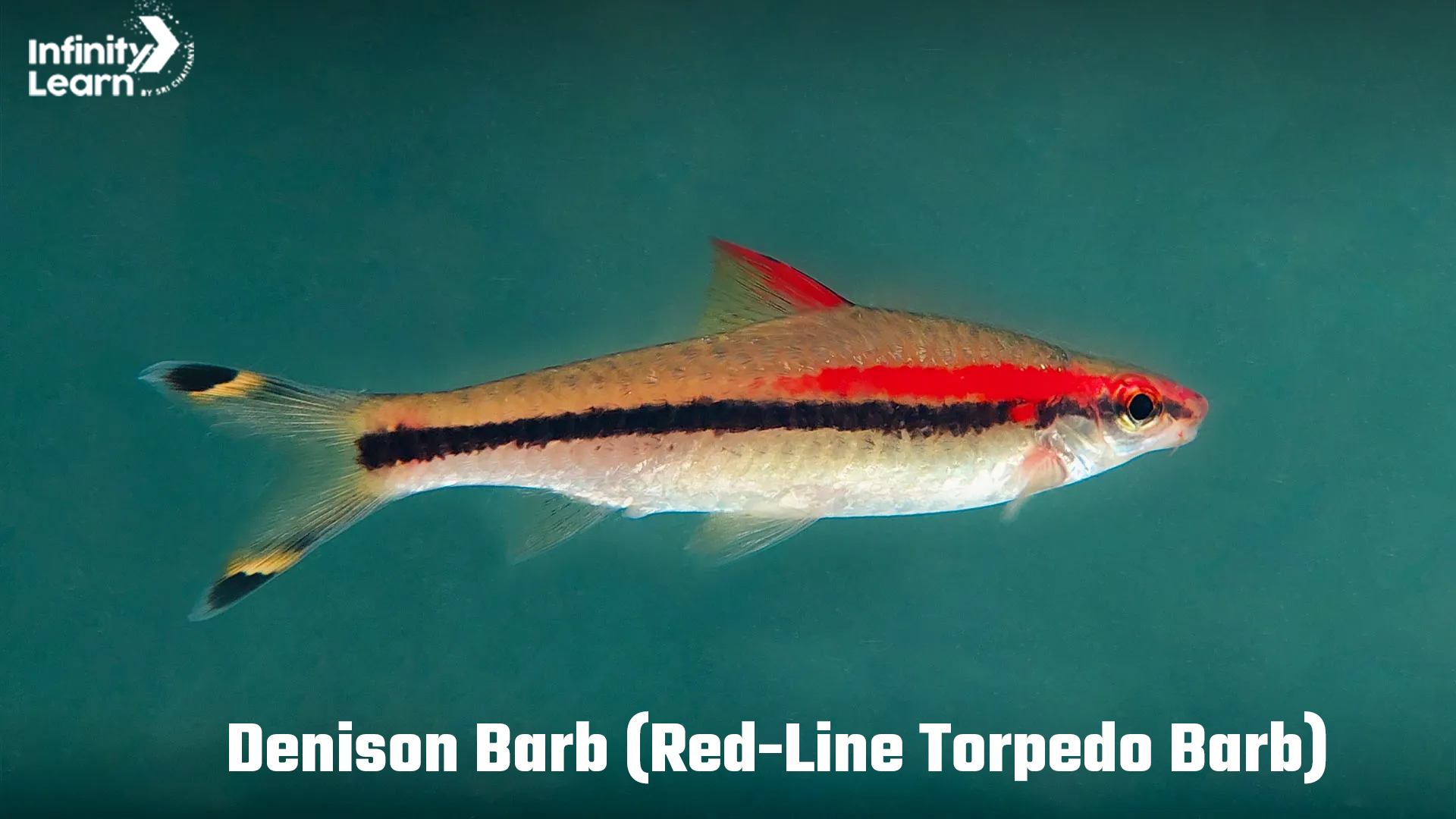
- Scientific Name: Sahyadria denisonii
- Place of Origin: India
- Size When Fully Grown: Up to 6 inches
- Expected Lifespan: 5 to 7 years
- Smallest Recommended Aquarium Size: 55 gallons
- Water pH Level: 6.5 to 7.8
- Water Hardness Level: 5 to 20 dGH
- Optimal Water Temperature: 60°F to 77°F (15°C to 25°C)
Black Ruby Barb
Black Ruby Barbs are small and peaceful fish with males that turn a stunning ruby red and black during the breeding season.
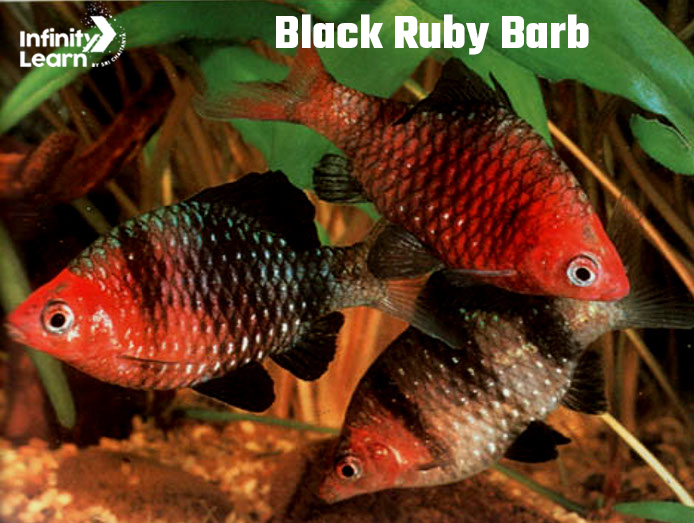
- Scientific Name: Pethia nigrofasciata
- Place of Origin: Sri Lanka
- Size When Fully Grown: Up to 2.5 inches
- Expected Lifespan: 4 to 5 years
- Smallest Recommended Aquarium Size: 20 gallons
- Water pH Level: 6.0 to 7.0
- Water Hardness Level: 5 to 10 dGH
- Optimal Water Temperature: 72°F to 79°F (22°C to 26°C)
Green Tiger Barb
Green Tiger Barbs are a color variant of the Tiger Barb, known for their vibrant green sheen and playful nature in aquariums.

- Scientific Name: Puntigrus tetrazona (color variant)
- Place of Origin: Bred from wild Southeast Asian stock
- Size When Fully Grown: Up to 3 inches
- Expected Lifespan: 5 to 7 years
- Smallest Recommended Aquarium Size: 20 gallons
- Water pH Level: 6.0 to 7.0
- Water Hardness Level: 5 to 19 dGH
- Optimal Water Temperature: 72°F to 82°F (22°C to 28°C)
Clown Barb
Clown Barbs are large and colorful, with a playful nature and striking patterns that make them a captivating addition to larger tanks.

- Scientific Name: Puntius everetti
- Place of Origin: Borneo, Sumatra
- Size When Fully Grown: Up to 6 inches
- Expected Lifespan: 5 to 7 years
- Smallest Recommended Aquarium Size: 30 gallons
- Water pH Level: 6.0 to 6.5
- Water Hardness Level: 5 to 10 dGH
- Optimal Water Temperature: 76°F to 80°F (24°C to 27°C)
Checkerboard Barb
Checkerboard Barbs are small, peaceful fish with a distinctive checkerboard pattern, suited for community tanks with similar-sized fish.
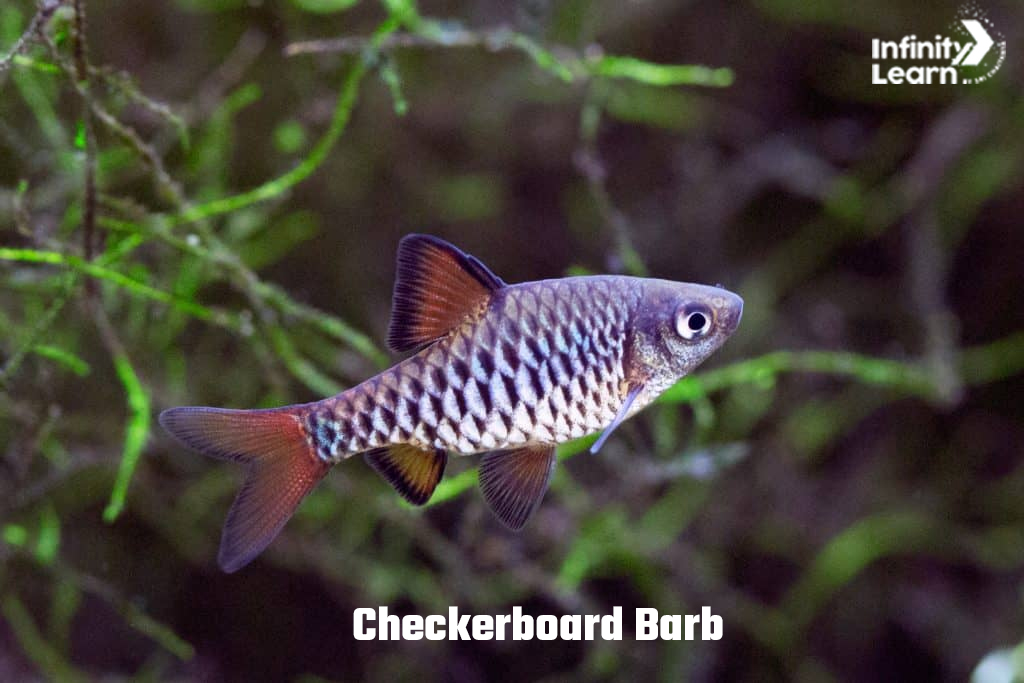
- Scientific Name: Puntius oligolepis
- Place of Origin: Sumatra
- Size When Fully Grown: Up to 2 inches
- Expected Lifespan: 4 years
- Smallest Recommended Aquarium Size: 20 gallons
- Water pH Level: 6.5 to 7.0
- Water Hardness Level: 5 to 12 dGH
- Optimal Water Temperature: 74°F to 78°F (23°C to 26°C)
Interesting Facts About
- Barb fish come from a big family called Cyprinidae, which has been around for ages. Because they’ve been around so long, they’ve learned to live in lots of different places.
- Barb fish often swim together in groups, not just to stay safe, but also to find food and get around better. It’s really cool to watch them all move together.
- In many types of barb fish, you can tell the boys and girls apart by their colors and shapes, especially when they’re trying to attract mates.
- Barb fish aren’t fussy eaters. They’ll eat pretty much anything, like flakes, live food, and veggies. This makes them easy to take care of.
- Some barb fish grow really fast if they have the right conditions, getting big in just a few months. But they need plenty of space and stuff to be healthy.
- When it’s time to have babies, many barb fish get really colorful to attract mates. You can see this a lot in fish like Black Ruby Barbs, where the males turn really bright.
- Barb fish can live in lots of different temperatures, so they’re good for different types of aquariums. But each type of barb likes its own temperature best.
- Some barb fish can mix and make new kinds of fish with their relatives. People who keep fish in aquariums like this because they get cool colors and patterns, but it can be bad for wild fish populations.
- In the wild, barb fish help keep bug numbers down and are food for other animals. They’re important for keeping their environment in balance.
- Barb fish are great for aquariums because they’re always moving and swimming together. They make the tank look really interesting.
FAQs on Barb Fish
Are barb fish aggressive?
Barb fish can be semi-aggressive, especially if they feel crowded or are not in a large enough group. Keeping them in schools can help reduce aggression, making them more peaceful towards other fish in the aquarium.
Are barbs good fish?
Yes, barbs are good fish for both beginner and experienced aquarium enthusiasts. They are hardy, adaptable, and their vibrant colors and active behavior make them an attractive addition to community tanks.
Why are barb fish called barbs?
Barb fish are called barbs because of the barbels (small, whisker-like sensory organs) found near their mouths. These barbels help them sense food in the water, giving them their name.
Do barbs lay eggs?
Yes, barbs lay eggs. Most barb species are egg scatterers, meaning they scatter their eggs over plants and substrate during breeding. They do not care for their eggs or fry after spawning.
What is the lifespan of a barb fish?
The lifespan of a barb fish varies by species but typically ranges from 4 to 7 years in a well-maintained aquarium. Proper care and diet can maximize their lifespan.
Do barb fish sleep?
Yes, barb fish do sleep. They have periods of rest where they are less active and may stay near the bottom of the tank or hide among plants. However, they don't close their eyes as they lack eyelids, so their sleep might not be obvious.







